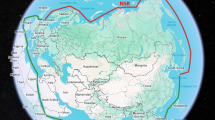Abstract
Radar sea clutter is the backscattering radar echo of rough sea surface, the research of radar sea clutter is of great significance to national defense construction and national economic development. Sea clutter prediction is also an important point in radar signal processing field. The traditional sea clutter prediction method has lower precision when predicting long-distance sea clutter data, and when the amount of data is large, the time is also lengthened, thereby reducing the efficiency of prediction. In this paper, a new method based on long short-term memory (LSTM) for predicting sea clutter at longer distances in the atmospheric duct environment using near-distance observations is proposed, the principle of LSTM network is introduced, and the factors affecting prediction accuracy are analyzed. The high precision prediction of radar sea clutter by LSTM network is realized. It provide the basis for further work on inversion problem of atmospheric ducts. It also has very important application value for studying the clutter suppression of the radar model and improving the target detection performance of the radar.









Similar content being viewed by others
Explore related subjects
Discover the latest articles and news from researchers in related subjects, suggested using machine learning.References
Bian-zhang XHMY (2004) Detecting weak signal in chaotic sea clutter using RBF neural network predictor. Mod Rad 2004:9
Bin J, HongQiang W, YaoWen F, Xiang L, Rong GG (2007) Prediction of Chaotic Sea clutter based on LS-SVM. Prog Nat Sci 17:415–420
Cai M, Cai F, Shi A, Zhou B, Zhang Y (2004) Chaotic time series prediction based on local-region multi-steps forecasting model. International symposium on neural networks. Springer, Berlin, pp 418–423
Chen XN, Xiao-Ke XU, Suo JD (2007) Forecasting method of chaotic time series based on RBF. J Dalian Marit Univ 33(1):115–118
Gerstoft P, Rogers LT, Krolik JL, Hodgkiss WS (2003) Inversion for refractivity parameters from radar sea clutter. Radio Sci 38:3
Guo X, Wu J, Zhang J, Han J (2018) Deep learning for solving inversion problem of atmospheric refractivity estimation. Sustain Cities Soc 43:524–531
Haykin S, Puthusserypady S (1997) Chaotic dynamics of sea clutter Chaos. Interdiscip J Nonlinear Sci 7:777–802
Haykin S, Bakker R, Currie BW (2002) Uncovering nonlinear dynamics—the case study of sea clutter. Proc IEEE 90:860–881
Hochreiter S, Schmidhuber J (1997) Long short-term memory. Neural Comput 9:1735–1780
Hope T, Resheff YS, Lieder I (2017) Learning tensorflow: a guide to building deep learning systems. O’Reilly Media, Inc., Newton
Karimian A, Yardim C, Gerstoft P, Hodgkiss WS, Barrios AE (2016) Refractivity estimation from sea clutter: an invited review. Radio Sci 46:1
Kawakami K (2008) Supervised sequence labelling with recurrent neural networks. Ph D thesis
Krolik J, Tabrikian J (1998) Tropospheric refractivity estimation using radar clutter from the sea surface. In: Proceedings of the 1997 Battlespace atmospherics conference, SPAWAR Sys. Command Tech. Rep, pp 635–642
Lapedes A, Farber R (1987) How neural nets work. In: Proceedings of the 1987 international conference on neural information processing systems. MIT Press, pp 442–456
Lecun Y, Bengio Y, Hinton G (2015) Deep learning. Nature 521:436
Levis CA, Johnson JT, Teixeira FL (2010) Radiowave propagation: physics and applications
Lin SH, Zhu H, Zhao YG (2004) Study of sea clutter chaotic dynamics. Syst Eng Electron 26(2):178–181
Liu Y, Zhou XL, Jin HQ (2011) Forecasting technique of radio propagation characteristics based on parabolic equation model. Mod Electron Tech 34(18):74–76
Tax N, Verenich I, La Rosa M, Dumas M (2017) Predictive business process monitoring with LSTM neural networks. In: Dubois E, Pohl K (eds) Advanced information systems engineering. CAiSE 2017. Lecture notes in computer science, vol 10253. Springer, Cham, pp 477–492
Ting XU (2015) Prediction of sea clutter based on GA-WNN. Electron Des Eng 23(18):34–37
Wang FY, Yuan GN, Zhi-Zhong LU, Hao YL (2007) Research on real-time wave height measurement using Xband navigation radar. Ocean Eng 25(4):84–87
Wang F-Y, Yuan G-N, Xie Y-J, Qiao X-W (2009) Nonlinear prediction of short-time sea clutter. Radar Sci Technol 1
Xi JH (2005) Research on long-term prediction method of chaotic time series. PhD thesis, Dalian University of Technology
Xiaohong S, Jidong S (2006) Prediction of sea clutter based on chaos theory with RBF and K-mean clustering. In: 2006 CIE international conference on radar. IEEE, Shanghai, China, pp 1–4
Xiaohong SU, Suo J, Liu X, Wang Y (2010) Sea clutter prediction based on linear and non-linear models. J Dalian Marit Univ 36:100–102 + 106
Xie L (2009) Research on clutter simulation and sea clutter prediction of broadband radar. University of Electronic Science and Technology of China
Zhang YH, Qiu CM, Xing HE, Ling ZN, Shi X (2017) A short-term load forecasting based on LSTM neural network. Electr Power Inf Commun Technol 15(9):19–25
Acknowledgements
The authors gratefully acknowledge the financial supports by the National Natural Science Foundation of China under Grant numbers 61775175 and 61801446.
Author information
Authors and Affiliations
Corresponding author
Additional information
Publisher's Note
Springer Nature remains neutral with regard to jurisdictional claims in published maps and institutional affiliations.
Rights and permissions
About this article
Cite this article
Zhao, J., Wu, J., Guo, X. et al. Prediction of radar sea clutter based on LSTM. J Ambient Intell Human Comput 14, 15419–15426 (2023). https://doi.org/10.1007/s12652-019-01438-4
Received:
Accepted:
Published:
Issue Date:
DOI: https://doi.org/10.1007/s12652-019-01438-4




